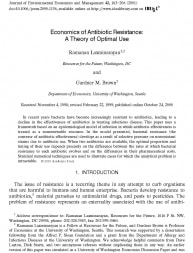May 27, 2010

In recent years bacteria have become increasingly resistant to antibiotics, leading to a decline in the effectiveness of antibiotics in treating infectious diseases. This paper uses a framework based on an epidemiological model of infection in which antibiotic effectiveness is treated as a nonrenewable resource. In the model presented, bacterial resistance (the converse of antibiotic effectiveness) develops as a result of selective pressure on nonresistant strains due to antibiotic use. When two antibiotics are available, the optimal proportion and timing of their use depend precisely on the difference between the rates at which bacterial resistance to each antibiotic evolves and on the differences in their pharmaceutical costs. Standard numerical techniques are used to illustrate cases for which the analytical problem is intractable.
This article can be accessed here.

